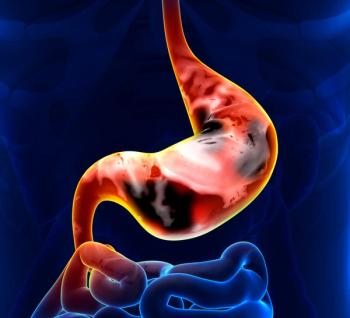
Combined Biomarker Expression May Be Significant Driver of Tumorogenisis in Colorectum
Using immunohistochemistry to measure the expression of certain target enzymes-cox-2 and 15-prostaglandin dehydrogenase (15-PGDH)-in premalignant colorectal adenomas, researchers were able to get significant predictive and prognostic information in patients treated with the cox-2 inhibitor celecoxib for prevention of colorectal adenomas.
Using immunohistochemistry to measure the expression of certain target enzymes-cox-2 and 15-prostaglandin dehydrogenase (15-PGDH)-in premalignant colorectal adenomas, researchers were able to get significant predictive and prognostic information in patients treated with the cox-2 inhibitor celecoxib for prevention of colorectal adenomas, according to data presented (
“Patients with higher cox-2 levels in baseline adenomas achieve the greater response to celecoxib for adenoma prevention,” said Jiping Wang, MD, PhD, of Dana-Farber Cancer Institute. “Subjects whose baseline adenomas retain 15-PGDH might not benefit with celecoxib treatment.”
According to Wang, celecoxib inhibits the expression of prostaglandin E2 (PGE2), an inflammatory mediator produced by fatty acid metabolism via cyclooxygenases, and degraded through the activity of 15-PGDH.
In the Adenoma Prevention With Celecoxib (APC) trial, 2,035 patients with large or multiple colorectal adenomas were randomly assigned to celecoxib 200 mg twice daily, celecoxib 400 mg twice daily, or placebo. Patients underwent colonoscopy at 1 and 3 years post colonoscopy. Results showed that celecoxib significantly reduced risk of adenoma recurrence compared with placebo.
Results from the APC trial showed that patients at high-risk for colorectal adenoma development had a 33% to 45% reduction in postpolypectomy adenoma detection when treated with a cox-2 inhibitor; however, there was also a small increase in cardiovascular toxicity among patients given celecoxib, preventing its widespread use for chemoprevention.
This study was designed to see whether markers of PGE2 expression in adenomas predicted benefit from celecoxib treatment for the prevention of colorectal adenomas. Using immunohistochemistry Wang and colleagues analyzed adenomas collected from 1,295 participants in the APC trial for two markers: expression of cox-2 (high vs low) and 15-PGDH (present vs absent). Cases were classified as PGE2 low (cox-2 low/15-PGDH present) or PGE2 high (Cox-2 high/15-PGDH present; cox-2 high/15- PGDH absent; or cox-2 low/15- PGDH absent).
At baseline, the majority of patients had 15-PGDH absent and PGE2 high. In the placebo group, there was no difference in adenoma recurrence in patients with either low or high cox-2 levels, which “indicated that pretreatment cox-2 level is not prognostic for adenoma recurrence,” Wang said.
However, celecoxib significantly reduced the risk for adenoma recurrence in both low and high cox-2 groups. The magnitude of risk reduction in the high cox-2 group appeared to be higher than the cox-2 low group. Specifically, there was a 51.6% reduction in risk for adenoma with celecoxib treatment in patients whose baseline adenomas had elevated cox-2 (relative risk [RR] = 0.37; P = .0001). Patients in the low cox-2 category had a less significant risk reduction (RR = 0.64).
“This suggests that higher cox-2 levels predict a greater response to celecoxib,” Wang said.
Among patients with 15-PGDH presence there was no strong evidence to indicate that celecoxib result in benefit this. In contrast, participants who had 15-PGDH loss, there was a 33.8% reduction in the risk for adenomas (RR = 0.60; P < .001).
“This tells us that 15-PGDH is not prognostic, but it is predictive for response to celecoxib,” Wang said.
Finally, among patients assigned placebo there was no difference in adenoma risk among patients with either low or high PGE2. Patients in the low estimated tumor PGE2 category did not benefit from celecoxib treatment for adenoma prevention (RR = 0.95; P = 0.83). However, those patients in the high PGE2 category had a 34.9% reduction in adenoma detection with celecoxib treatment (RR = 0.59; P < .0001).
“A combined biomarker of both cox-2 and 15-PGDH expression yields results driven primarily by 15-PGDH,” Wang said. “These results suggest that PGE2 is a significant driver of tumorigenesis in the colorectum for many, but not all adenoma patients.”
Newsletter
Stay up to date on recent advances in the multidisciplinary approach to cancer.





















































































